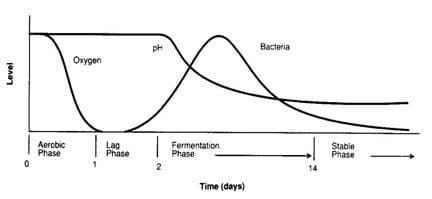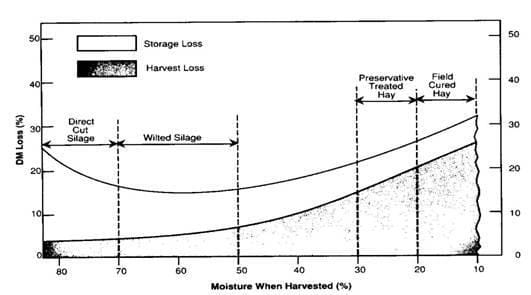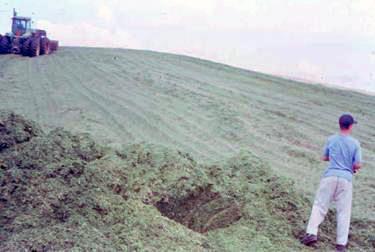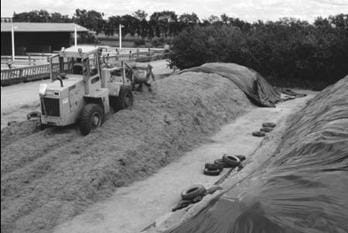Silage
Silage is the feedstuff resulting from the preservation of green forage crops by acidification. There are two main phases in the ensiling process, the first is the aerobic phase and the second is anaerobic phase.
- Aerobic phase - occurs in the presence of oxygen (air). The oxygen that is present in the forage, as it is placed into storage, is consumed by the plant material through the process of respiration. Under aerobic conditions, plant enzymes and microorganisms consume oxygen and burn up plant water-soluble carbohydrates (sugars), producing carbon dioxide and heat.
- The first phase should be as brief as possible to maintain the quality of the silage. Excessive aerobic fermentation reduces the energy content of the silage and may cause heat damage to proteins.
- Anaerobic phase - begins when available oxygen is used up by respiration and aerobic bacteria cease to function. Anaerobic bacteria (bacteria that grow in the absence of oxygen) then begin to multiply rapidly and the fermentation process begins.
The best silage is produced when the most rapidly growing microorganisms are predominately of the lactobacilli species, as they produce lactic acid from the fermented plant material. Lactic acid lowers the pH of the silage. Fermentation completely ceases after three to four weeks when the pH becomes so low that all microbial growth is inhibited.

Source: Nutritional Ecology of the Ruminant, P. Van Soest, Cornell University Press, 1994, p. 217.
There are several ensiling/storage methods that will accomplish the ensiling process. All methods have advantages and disadvantages, and have widely ranging capital costs.; Some methods of storing silage include trench, bunker, concrete silos, oxygen-limiting silos, heap silage, and bale silage.
Whatever the system, the ensiling and storage system's main functions are to exclude air during the ensiling process and to prevent air from entering the silage during storage.
Limiting air present in the silage will enhance feed quality and reduce spoilage. Slow silo filling, forage that is not chopped finely enough, inadequate packing and allowing air to enter stored silage will all reduce quality.

Efficiencies of some silage and other feed storage methods are outlined in Table 1. and Figure 2. Dry matter losses can be significantly reduced with good production practices, e.g., mending tears in plastic covers, using concrete floors, etc.
TABLE 1. Estimated average losses (%) for various forage harvesting systems
| Type of dry matter loss | Horizontal Pit/bunker 65% M.C. | Concrete tower 65% M.C. | Oxygen limiting tower 45% M.C. | Silage bags (tubes) 65% | Round bale silage 65% | Square bale hay (sheltered) 20% M.C. | Round bale hay (Outside) 25% M.C. |
| In field prior to harvesting | 2 | 2 | 2 | 2 | 2 | 10 | 10 |
| Harvesting loss | 1-2 | 1-2 | 1-2 | 1-2 | 2-3 | 4-6 | 3-5 |
| Storage loss | 10-20 | 8-9 | 4 | 5-9 | 10-25 | 2 | 6-8 |
| Feeding loss | 4 | 2 | 2 | 4 | 4 | 5 | 5 |
| Total | 17-27% | 13-15 | 9-10% | 12-17% | 19-34% | 21-23% | 24-28% |
Horizontal Silos
There are two types of horizontal silos - below ground level (i.e., pit or trench) and above ground (i.e. bunker and stack). The main advantage of horizontal silos is their low capital cost and suitability to feeding livestock in widely separated pens.
Trench silos

are effective and stable
Trench silos are usually dug into a slope with the "downhill" end open for drainage and access. It is preferable to have the open end facing south. Earth walls should be sloped at a ratio of 1:2 to prevent caving in and to enable adequate silage packing. Where soil is unstable, it is necessary to line the walls with concrete or untreated wood. A convenient width for loading with a tractor and front-end loader is 15 m (50 ft.). A reinforced concrete floor sloped one to two per cent toward the open end will drain and stand up under high moisture from silage, rainfall and spring thaw.
Bunker silos
Bunker silos are used in flat areas unsuitable for trench silos. Above-ground walls are constructed using concrete, earth or wood and braced with timbers or concrete buttresses. Round bales lined with plastic have also been used for bunker silo walls. Wood that comes into contact with silage should not be treated with preservatives. Permanent wood lining or walls should be covered with plastic to prevent moisture and acid penetration. Bunker silos require adequate drainage. Concrete floors are usually needed for easier loading and to minimize feed waste. Where earth floors are used, traffic must be limited (particularly animal self-feeding).
Maintain the front slope as steep as the packing tractor can climb without spinning when filling horizontal silos. Silage layers should be added as quickly as possible. The layers are packed into place by a heavy tractor driven on the pile surface. The tractor compresses the silage mass forcing the air out. Pack promptly after adding material in thin layers less preferably a few inches thick but no more than two feet thick. The packed surface should feel firm, not spongy, to walk on.
It can be difficult to pack the top one or two feet of cereal silage adequately. After a break in harvesting, add new silage before packing. The next load of silage added will seal air from the packed silage underneath.
Only experienced operators should pack on a horizontal silo. Packing tractors should be equipped with rollover-protected cabs. Wheels should be set as far apart as possible, tractor speeds should be slow and the tractor should be weighted to have a low centre of gravity.
Once the top surface has been properly packed, it should be covered immediately with six millimetre thick silage-grade polyethylene or reinforced plastic to prevent air or rainfall from entering the silage. Air entering silage causes spoilage and rainfall washes organic acids out of the silage, and introduces oxygen into the silage, increasing the pH and encouraging spoilage. White plastic is preferable, due to its superior UV resistance, reduced silage temperatures beneath it, and reduced freezing problems during winter.
Stack Silage

Photo courtesy Agriculture and Agri-Food Canada
Silage stacks are best used for storing an unexpected surplus of forage or as an interim method when first trying silage. Stacks should be located in an area sheltered from the wind and have a 15 to 30 cm slope away from the stack location. Stack width should be fitted to the size of plastic cover to be used. For instance, if a 13 X 33 m (40 X 100 ft.) plastic cover is being used, the base of the pile should be 9 to10 m (27 to 30 ft.) in width.
The leading edge of the stack should be maintained at a 30-degree angle and packed lengthwise with a tractor. The entire stack should be covered during breaks in harvesting and the end uncovered when harvesting resumes. Since a stack has a large surface area exposed to oxygen and weather, potential for spoilage can be high. Prompt covering and effective anchoring of the cover is effective at reducing losses. The use of a large stack also minimizes the amount of surface spoilage.
The most efficient shape is a domed stack. This also permits tractor packing over the entire surface. The packing tractor must be operated carefully. The width and length of the stack are also affected by the removal rate for feeding. At least 10 cm (4 in.) should be removed daily, to minimize spoilage.
